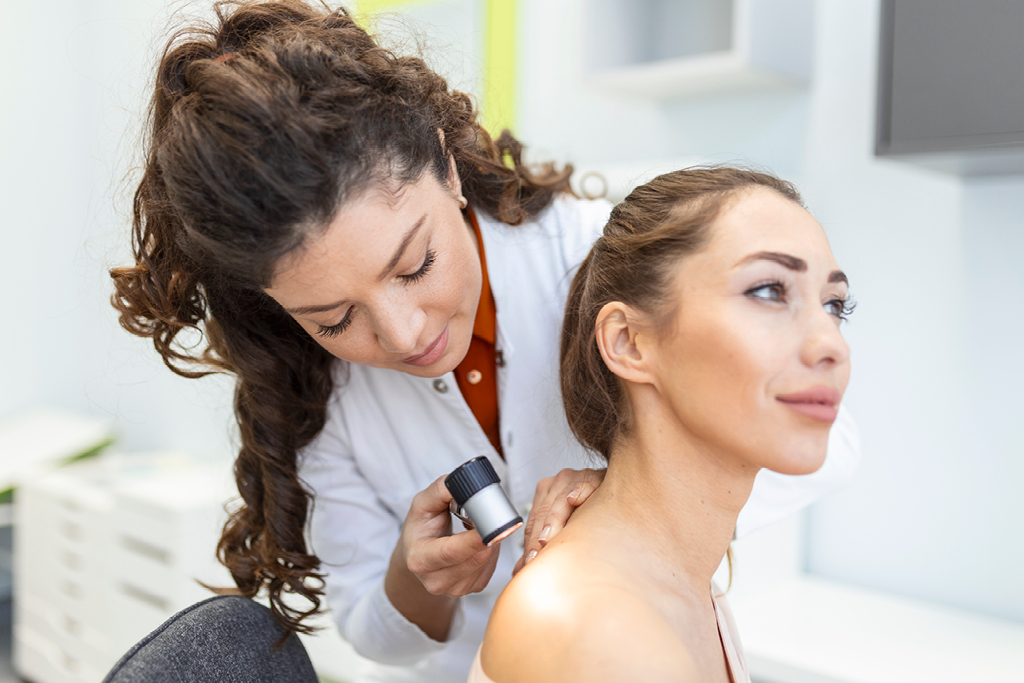
A skin cancer screening is a crucial part of your health care.
And although it can feel daunting to have such a test, the procedure is easy. In this post, we’ll cover what to expect, how to prepare, and what puts you at higher risk.
Also, we’ll take a look at home exams.
What is skin cancer?
It’s a condition in which abnormal cells grow in your skin, the body’s largest organ. It often causes a tumor to form in the two main layers: the epidermis and dermis. Skin cancer is the most common type, and affects people of all skin types.
It’s easier to treat if discovered in the early stages. There are three kinds:
- Basal cell carcinoma. It occurs within the skin cells that produce new cells as old ones die off. A flesh-colored, red, pearl-like bump or a pink/red patch can appear on the skin.
- Melanoma. Anywhere there is exposure to sunlight, natural or artificial, it can develop as moles. These are dark, irregular-shaped flat spots (or bumps) on the skin with or without many colors. Melanoma can spread to other body parts, be more difficult to treat, and become fatal. It’s easy to treat if caught before it spreads beneath the top layer of skin. Your health history can affect your risks.
- Squamous cell carcinoma. It’s a common condition that forms in the cells that comprise the skin’s middle and outer layers. It appears as a scaly red bump and is usually not life-threatening, but it can be aggressive.
How can I prepare for a skin cancer screening?
Before you see a doctor, you should be practicing an early detection strategy. Experts suggest doing so monthly, starting at age 18. It’s as simple as knowing your own skin.
Get familiar with your blemishes, freckles, and moles, so you’ll recognize any irregularities cropping up. Note unusual:
- Color
- Shape
- Size
- Texture
You should see a dermatologist yearly, or more often if you’re at higher risk. Schedule a full-body, professional skin examination for maximum results. Before you go in, take these five steps:
- Conduct a self-examination. Take notes of any changes, or new or unusual marks to tell your doctor about. If you notice spots changing, take smartphone photos to share during your appointment.
- Remove nail polish. Skin cancers can form on fingers, nails, and nail beds. Make it easy for your provider to examine them.
- Wear your hair loose. No buns, clips, or ponytails. Your doctor will take a thorough look at your scalp.
- Bring makeup remover. You should take makeup off before your exam. Your doctor will want to look at the skin around your eyes.
- Ask questions! Take advantage of the guidance and wisdom of a trained professional. Ask for explanations of terms you’re not familiar with. Your dermatologist can show you how to perform a skin self-exam. A doctor can also give you valuable information about prevention.
What should I expect at a skin cancer screening?
Patients who’ve never had atypical moles or skin cancer can expect a quick exam, about 10 minutes. Your doctor will ask you to remove all clothing except undergarments and to wear an exam gown. You can keep your underwear on unless you have concerns about a spot under them.
The exam will cover your entire body, including hard-to-see areas, such as:
- Back
- Behind your ears
- Between your toes
- Buttocks
- Scalp
Your doctor might use a dermatoscope. This magnifying instrument pictures the skin’s outer surface or epidermis. It also takes a look at the skin layers beneath the epidermis.
What if there are spots of concern?
Your physician might order a biopsy of questionable spots, including extracting part of or the whole lesion for lab analysis. If it tests positive, your doctor will discuss the type of cancer it is and treatment options.
What puts you at high risk of skin cancer?
Skin cancer risk factors include natural or artificial sun exposure and age. As you age, your risk increases. Other things that affect your risk include:
- Family history. Have two or more blood relatives had melanoma?
- Natural eye, hair, and skin tones are lighter. Blue or green eyes, blond or red hair, and light skin.
- Many moles. Do you have several atypical moles? Typical moles are benign, but atypical moles have the following:
- Asymmetrical shape
- Uneven borders
- Varying coloration
- Several actinic keratoses spots. These precancerous lesions are gray or pink scaly patches of skin. They’re found in spots exposed to natural or artificial sunlight.
- Skin that burns, freckles, or reddens. Does your skin become painful in the sun?
- A history of basal or squamous cell skin cancers.
Schedule your skin cancer screening today
Wilmington Health has board-certified physicians, nurse practitioners, and physician assistants who can provide complete care for all skin issues. We are experts in evaluation, consultation, and surgery for skin cancers.
Our innovative range of therapies includes laser and photodynamic treatments. Learn more today and schedule your skin cancer screening.
